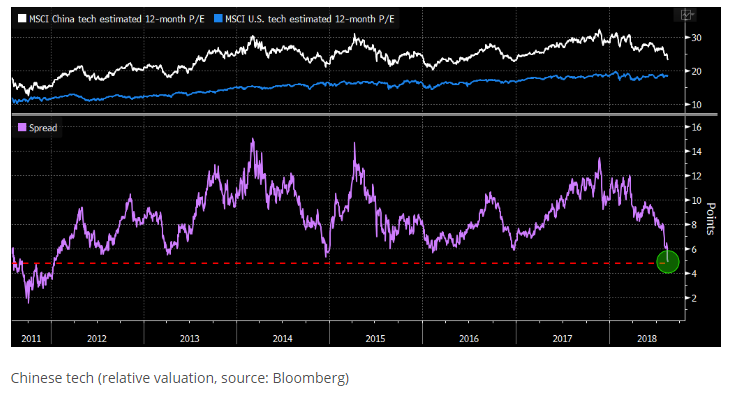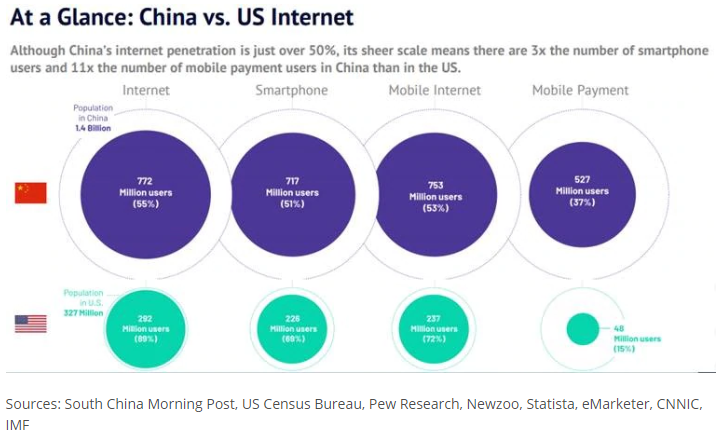Invest
What's next for Chinese tech?
The entrepreneurial vision in China along with state-backed funding has led to one of the fastest growing and vibrant start up scenes in the world, rivaled only by that of Silicon Valley.
What's next for Chinese tech?
The entrepreneurial vision in China along with state-backed funding has led to one of the fastest growing and vibrant start up scenes in the world, rivaled only by that of Silicon Valley.

China's tech sector, under the government initiatives of “Internet Plus”, “Made in China 2025”, and “Outline on the National Information Technology Development Strategy”, is emerging as an innovation and technology powerhouse.
Year-to-date, however, the Chinese tech sector has significantly underperformed its US counterpart. At the beginning of the year, the biggest issue weighing on Chinese equities was the government’s financial de-risking campaign and quasi fiscal moderation. In order to try and de-risk its economy, China has been on strict path to deleverage, with stricter financial regulation and rules to curb shadow banking and misallocation of capital to non-productive areas of the economy. Add to this trade frictions, slowing economic growth, tightening US monetary policy, and a stronger dollar, and we see a perfect storm in Chinese equity markets that has sent them into a tailspin since the beginning of the year.
As economic data began to cool off and miss estimates, the Chinese government pre-empted a growth slowdown and stepped in in to ensure economic growth was not compromised. A double-barreled fiscal and monetary easing campaign has been enacted. There have already been three reserve ratio requirement cuts this year (with more expected), record medium-term lending facility liquidity injections, and a fiscal stimulus package including 65 billion yuan in tax cuts, expanding the preferential policy for small firms to all firms plus an infrastructure spending package all aimed at boosting domestic demand.
All this signals a policy shift towards easing, which is likely to support growth momentum in China for the time being – something that markets may be underestimating at the moment. Although the policy efforts introduced so far do not amount to broad-based easing as seen in 2009, these measures should not be underestimated.
The valuation of Chinese tech has been extreme relative to the US. As the graph below shows, historically a basket of Chinese tech companies trade at a valuation premium to US tech when comparing P/E ratios due to stellar growth. Now that actual growth is no longer meeting expectations, we are seeing a repricing across the sector as a whole. The market is revaluing Chinese tech stocks based on a slowing growth trajectory rather than a structural problem within the sector. For example, Tencent shares fell 6.67 per cent in the US after reporting weaker than expected numbers but it is still one of the fastest-growing technology companies in the world, as Saxo Bank head of equity strategy Peter Garnry recently pointed out.

Valuations have corrected significantly within the Chinese tech sector and the A-shares market. The valuation premium for Chinese tech is now the lowest since 2012 (see above graph), which may present an opportunity for long-term investors. As Mr Garnry notes, it’s often when others hesitate that one should act. When China’s stimulus begins to halt the weakness, the market will likely reprice the A-shares market as there remains attractive opportunities and even more so now at the current low valuation compared to developed markets.
Overall, the Chinese technology sector remains exciting in the longer term. The ecosystem contains a variety of interesting businesses with significant opportunities with the ability to drive growth and increase profitability for investors. Demographic shifts, with the rapid rise of the Chinese middle class and a burgeoning economy, have unleashed a wave of consumer engagement in China resulting in a decade of hyper-digitisation from which the tech sector can benefit from.
According to the China Internet Network Information Center, China’s online user base has increased to 800 million as at August 2018, double the population of the US – and it still has room to grow. According to Internet World Stats, only 54.6 per cent of the population in China is online compared with 89 per cent in the US.
We expect internet penetration and sector revenues to continue rising in the coming years due to the following:
1. China has a similar proportion of city dwellers as the US did in 1940 with a population approximately five times the size of the US, illustrating that there are still decades of above-average growth and urbanisation to come.
2. According to McKinsey & Company, China’s mobile payments ecosystem is already 11 times larger than the US; as these trends continue to emerge it will be critical for Chinese consumers to be online.
Besides the three tech gaints – Baidu, Alibaba, and Tencent – there is an abundance of technology companies listed on Chinese, Hong Kong and US exchanges who benefit from state support due to Beijing's plans for the Chinese economy as well as demographic trends in the country. But despite government support, these firms operate with entrepreneurial drive in what Baidu's chief scientist described as a “permanent state of war”, driving consistent growth within China’s tech sector.


Top Chinese tech stocks by market capitalisation
Alibaba Group Holding
Tencent Holdings
Baidu Inc.
Hangzhou Hikvision Digital Tec
Netease Inc.
360 Security technology Inc.
Iqiyi Inc.
Hanergy Thin Film Power Group
Focus Media Information technology
Weibo Corp
Eleanor Creagh is Australian markets strategist at Saxo Bank.

Investment insights
Global deal activity declines by 6% amid challenging market conditions, reports GlobalData
In a year marked by economic uncertainty and geopolitical tensions, global deal activity has experienced a notable decline, according to recent findings by GlobalData, a prominent data and analytics ...Read more

Investment insights
Furious five trends set to reshape the investment landscape in 2026
The investment landscape of 2026 is poised for transformation as five key trends, dubbed the "Furious Five" by CMC Markets, are set to dominate and disrupt markets. These trends encompass artificial ...Read more

Investment insights
Investors maintain cautious stance amid data uncertainty
Amidst the backdrop of a US government shutdown and lingering economic uncertainties, investors have adopted a neutral stance, as revealed by the latest State Street Institutional Investor IndicatorsRead more

Investment insights
State Street's 2026 global market outlook anticipates cautious growth with strategic investment shifts
State Street Investment Management, the world's fourth-largest asset manager, has released its much-anticipated 2026 Global Market Outlook (GMO) report titled "Forward with Focus." The report provides ...Read more

Investment insights
J.P. Morgan strategists highlight Australia as a key investment destination amidst global uncertainties
Amidst a backdrop of fluctuating energy prices, J.P. Morgan Private Bank strategists have identified Australia as a beacon of opportunity for global investors, particularly within its fixed income and ...Read more

Investment insights
HarbourVest Partners unveils new private equity benchmarks highlighting long-term outperformance
In a significant update for the private equity world, HarbourVest Partners, a leading global private markets investment firm, has released its quarterly private equity benchmarks, providing ...Read more

Investment insights
Mason Stevens strengthens UHNW offering through partnership with GloryHouse
In a strategic move set to bolster its position in the ultra-high-net-worth (UHNW) sector, Mason Stevens, a prominent name in Australia's wealth management landscape, has announced a partnership with ...Read more

Investment insights
Beyond the trophy: What the Women in Finance Awards 2025 signal for strategy, talent and ROI
Australia’s Women in Finance Awards have crowned their 2025 cohort, but the real story isn’t the stage—it’s the strategy. Recognition programs now function as market barometers, signalling which ...Read more

Investment insights
Global deal activity declines by 6% amid challenging market conditions, reports GlobalData
In a year marked by economic uncertainty and geopolitical tensions, global deal activity has experienced a notable decline, according to recent findings by GlobalData, a prominent data and analytics ...Read more

Investment insights
Furious five trends set to reshape the investment landscape in 2026
The investment landscape of 2026 is poised for transformation as five key trends, dubbed the "Furious Five" by CMC Markets, are set to dominate and disrupt markets. These trends encompass artificial ...Read more

Investment insights
Investors maintain cautious stance amid data uncertainty
Amidst the backdrop of a US government shutdown and lingering economic uncertainties, investors have adopted a neutral stance, as revealed by the latest State Street Institutional Investor IndicatorsRead more

Investment insights
State Street's 2026 global market outlook anticipates cautious growth with strategic investment shifts
State Street Investment Management, the world's fourth-largest asset manager, has released its much-anticipated 2026 Global Market Outlook (GMO) report titled "Forward with Focus." The report provides ...Read more

Investment insights
J.P. Morgan strategists highlight Australia as a key investment destination amidst global uncertainties
Amidst a backdrop of fluctuating energy prices, J.P. Morgan Private Bank strategists have identified Australia as a beacon of opportunity for global investors, particularly within its fixed income and ...Read more

Investment insights
HarbourVest Partners unveils new private equity benchmarks highlighting long-term outperformance
In a significant update for the private equity world, HarbourVest Partners, a leading global private markets investment firm, has released its quarterly private equity benchmarks, providing ...Read more

Investment insights
Mason Stevens strengthens UHNW offering through partnership with GloryHouse
In a strategic move set to bolster its position in the ultra-high-net-worth (UHNW) sector, Mason Stevens, a prominent name in Australia's wealth management landscape, has announced a partnership with ...Read more

Investment insights
Beyond the trophy: What the Women in Finance Awards 2025 signal for strategy, talent and ROI
Australia’s Women in Finance Awards have crowned their 2025 cohort, but the real story isn’t the stage—it’s the strategy. Recognition programs now function as market barometers, signalling which ...Read more








